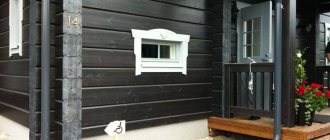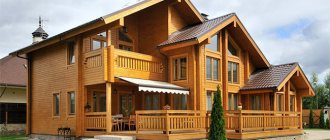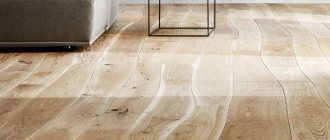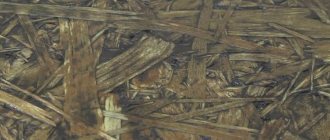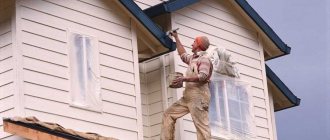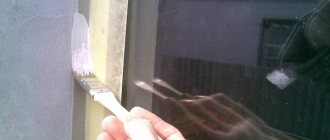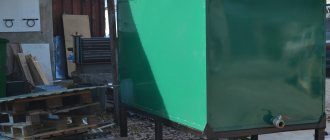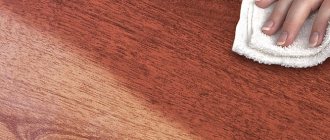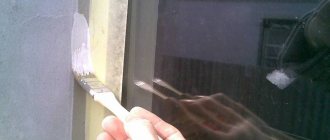Over the years, material such as wood darkens. And a house built on its basis also loses its initially presentable appearance. Therefore, it is not surprising that many residents of old log houses are looking for a good coloring agent in order to restore the former beauty of their home. After all, the choice of paint for log houses is not easy to make and any coloring composition will not work. So, how can you paint a log house that has lost its beauty over time?
What should be the means for painting a log house?
Coloring agents for log houses must have the following properties:
- Environmental friendliness. This is the most important property. After all, its residents have constant contact with the log house, and inhaling chemical vapors is very harmful to the health of people and animals.
- Attractive type of coating. Such a surface will be fully provided by acrylic, oil compositions or varnishes.
- Fire protection. Fire is the main and dangerous enemy of a log house. Therefore, it is advisable to purchase paints containing fire retardants.
- Protection from insects and biodestroyers. This property is not required for paint, but still desirable. And there are many coloring products on the market with such protective properties. They will prevent the appearance of mold, fungi and form a protective coating against insect pests.
In the markets, even knowing all the rules for choosing paint for a log house, making the right choice will not be easy. Even the price of a product will not help you distinguish the quality of a product. Nowadays, expensive material does not always have excellent characteristics. Therefore, you need to trust and purchase only proven and well-known brands, such as Neomid. They produce various coloring agents for painting any wooden materials and structures made from them. They can also choose an effective means for painting a log house. It is better to use two types of paints. Some with more effective and protective properties should be chosen for external painting, because... there will be more negative impacts on the surface (rain, sun, snow, frost, wind, etc.). And for painting outside, the requirements for paint properties can be set to minimum, the main thing is that they be environmentally friendly. From the Neomid company these are Biocolor Ultra and Biocolor Aqua.
Complete ecology and savings
This is also possible if you use old-fashioned secrets in painting surfaces, because at that time there were no protections from the chemical industry. So, what is the best way to paint the outside of a log house in order to achieve an environmentally friendly surface without overpaying huge sums:
- Waste oil. Vegetables are not suitable here - all the local insects will flock to the smell. It is best if it is machine made. The smell will disappear over time, but the impregnation will remain. This will be the waterproof layer. They need to be “painted” using a coarse brush, carefully rubbing in the composition. You'll need a lot of it.
- Wax and turpentine. By mixing in equal parts, you will receive protection from beetles and rodents. In addition, such a coating will give a shine to the structure, even if it is already old.
- Starch and ocher or another dye - this mixture can be used as a fire retardant - fire protection + decorative coating.
- It is better not to use coloring compounds such as onion decoctions or other ready-to-eat products and waste from them. The smell will attract biological threats.
- Laundry soap can be used as a moth repeller. It is used to rub inter-crown seams after caulking. But you should know that after some time it will be washed off, so protection is done from the inside.
- Oak bark decoction. Wonderful dye. It will give the building a dark background, but the wood pattern will be clearly visible through it. This method has been used for a long time and is still used today.
Don't get too carried away with environmental cleanliness. Sometimes it cannot compete with the products of the chemical industry, and the natural choice is too limited and troublesome.
It is better to use it for internal surfaces. And the external ones, which are more susceptible to various damages, need to be protected as carefully as possible. And then, even an outdated wooden house can be given a second life.
Tatiana Polyakova
Author of publications on 1Drevo.ru with the topics: Wooden Euro-windows | Sealing cracks in a log house | Calculation of house construction | Choosing a roof | Two-story houses | Houses made of cylinders | Heating Plan | Electric heating | Frame verandas | House made of timber 7 by 9 | House lining with bricks | Decorating the house outside | Facade insulation and others.
Collections of publications on topics:
Primer for wood Varnish for wood Painting of profiled timber
Was this publication useful to you?
Bookmark it on social networks!
Total score: 6Votes: 5
Using the attic floor when building a log house
Waterproofing technology between the log house and the foundation
We recommend! — Encyclopedia Wooden Houses — NEW
You can find out detailed and expanded information on the topic of the article from the book “Wooden Houses,” which reflects all stages of building a house, from laying the foundation to installing the roof. Book price = 77 rubles.
You may also be interested in other BOOKS on building houses from wood with your own hands.
We recommend other posts on this topic:
Sanding a house made of timber: features and recommendations
What is the effect of decorative finishing of a log house with jute rope
Types of finishing of facades of wooden houses with various materials
Finishing a house made of calibrated logs
How to plaster walls in a wooden house from the inside
Interior finishing of the log house after shrinkage
Neomid Biocolor ultra for painting the outside of a log house
Biocolor Ultra is an alkyd glazing composition, which is intended for decorative and protective finishing of log houses. It penetrates deeply into the wood and does not change its structure, but on the contrary, even emphasizes it favorably. After painting, a translucent, semi-matte layer is formed on the surface of the log house. It will protect the wooden material from the negative effects of sunlight, fading, precipitation and cracking. Also, this glazing composition will prevent the appearance of fungi, mold, insects, and dangerous bark beetles on the surface. There are 9 ready-made basic shades of paint; if desired, you can also tint using a colorless composition and special pastes. For 9 liters of this composition the cost is on average 2,150 rubles.
Requirements for paints for exterior painting of timber
When choosing a material for painting a bath, it is recommended to determine its characteristics and follow certain rules.
Article on the topic: How to make a stone fence yourself
Vapor permeability
This is the main indicator when choosing a material. If the shell is too dense, steam accumulates on the wall underneath it, which leads to rotting of the wood. After several years of operation, gradual peeling of the composition is observed.
The basis
When choosing a material, pay attention to the solvent. For cladding baths, preference is given to organic compounds or paints that are water-based. An organic solvent creates a dense film base that is not capable of fully transmitting steam. When purchasing organic compounds, you need to use paints based on plyolethyl resins.
Water-dispersed paints are developed on the basis of film formers. This is an environmentally friendly composition based on aqueous dispersion or minerals. The first type is:
- Water-dispersed;
- Emulsion;
- Latex;
- Water-based.
For the production of mineral paints, inorganic binders in the form of liquid glass, cement, and lime are used. Enamel paints form a practically non-breathable film, so they are not used for painting baths. When used, the texture of the wood is completely painted over, which leads to its destruction. Timber is not painted with modern synthetic materials, since they contain carcinogens that negatively affect the environment.
Waterproof
On the painted side, the paint should have low absorption capacity, which will protect the facade from getting wet and dirty. When purchasing a composition, you need to pay attention to its absorption level. If the timber is damp, then a temporary antiseptic is used to cover it, which does not form a dense moisture-proof film. Its tinting is carried out to protect it from ultraviolet radiation.
Protection of decorative qualities
The material used to construct bathhouse walls can accumulate dust particles, so care must be taken to ensure that they are washed off by rain. In high-load areas, compounds are used that have a high level of abrasion - over 5000. The floor of the veranda is covered with terrace paint.
UV resistance
When exposed to ultraviolet radiation on the walls of the bathhouse, the possibility of fungus spreading is eliminated. But the sun burns the paint and helps lighten it. Therefore, you need to buy a composition that is resistant to ultraviolet rays. The bathhouse is painted with polysilicon, acrylic or silicone composition. To avoid darkening of the surface, do not use paint based on linseed oil.
Article on the topic: How many meters from the fence can you build a bathhouse 2014
How to paint a log house with Biocolor Ultra
Before use, the product only needs to be mixed; there is no need to dilute it with anything. You can use a brush, roller or spray gun to apply Biocolor Ultra. But for applying paint with a spray device, it can be diluted with white spirit. Before painting, it is recommended to treat the surface with antiseptic compounds, and if the log house has already been affected by mold, then you need to get rid of colored stains using a special bleach. It is recommended to paint the log house in several layers. Please note that the paint is flammable, so smoking while working and lighting a fire nearby is prohibited. The surface dries completely after 24 hours. Paint consumption depends on the properties and condition of the log house.
Let's start painting
The sequence of processing walls inside and outside is the same:
- antiseptic;
- fire retardant (fire treatment);
- coloring.
The antiseptic will protect the tree from rot and prevent the proliferation of fungal spores. The fire retardant forms a film layer and contains salts that prevent fire. The paint will protect against temperature changes and moisture, and will retain the beneficial properties of the first two layers for a long time.
If the bathhouse is no longer new and the wood has changed its color, then before you start painting, you can use special wood bleaches. After using them, rinse the surfaces well, dry them and you can start painting.
Article on the topic: How to build a fence on an uneven area
Neomid Biocolor Aqua for painting the inside of the house
For interior painting of a log house, Biocolor Aqua from Neomid is perfect. This is a glazing acrylic composition that has not only decorative properties, but also protective ones. The paint penetrates deeply into the wood of the log house, beautifully highlighting its structure. After painting, a semi-matte, translucent layer is formed on the surface. It protects the frame from fading, moisture and cracking. Also, in the future, insects, molds, and fungi will not appear on the walls of the log house. It is important that the aroma of the wood is preserved; the composition itself has practically no odor. Biocolor Aqua is also an environmentally friendly and safe product. There are 7 primary colors in the paint arsenal. If desired, you can tint it with special pastes.
Bath - treatment
You can only paint the frame of a bathhouse from the outside. Since when interacting with steam, volatile chemicals will have the most unfavorable effect on visitors.
All kinds of impregnations of environmental significance are used for bath wood. Products must be labeled with the phrase “for baths and saunas.”
When the question arises of how to paint the outside of a bathhouse frame, the only thing that distinguishes such impregnation from other compositions is that it would be better if it were water-based so that the wood could breathe.
By the way, the ends of wooden buildings, other than protective components, are not covered with anything that could prevent the massif from releasing excess moisture - varnishes and oil paints are excluded.
How to paint a log house Biocolor Aqua
The glaze composition is produced ready for use. The ambient temperature during painting should exceed + 5 degrees. The surface must be clean and dry, without the presence of fungi and mold (if any, you need to get rid of them and their traces using wood bleach). It is advisable to treat the log house with antiseptic compounds before applying paint.
Photo: as an antiseptic treatment, it is best to buy and apply Neomid impregnation products.
Tools can be used as desired (roller, brush, spray gun). It is allowed to dilute the paint with a small amount of water when applying it with a spray gun. You need to paint in several layers. Is a fireproof paint. The surface dries after 12 hours. During work, you need to be careful not to get the composition on the mucous membranes and skin.
Photo: Traditional paint brushes work well as a tool for impregnation and painting.
It is quite possible to return an old log house to a beautiful, presentable appearance. To do this, you just need to choose the right paint and paint the frame. When choosing, the main thing is to rely on the popularity of manufacturers and consumer recommendations.
Preparatory work
Before impregnation, the old coating is removed with a sanding disc.
Before painting, the previous wall covering (plaster or paint material), if any, must be removed. This procedure requires tools with abrasive qualities: a metal brush, sandpaper or spatulas. It is possible to use a grinder with a special attachment. Since the operation is accompanied by the generation of a large amount of dust and small particles, you need to protect your respiratory tract with a respirator and wear special glasses.
You also need to remove paint from the joints of boards or logs. To make the operation faster, you must first remove the trim, drainage structures and shutters. Even if the coating is difficult to remove, it must be removed, otherwise after applying new paint it is likely to peel off. Dust and dirt are also removed from the façade of the home.
The surface must be sanded. If fungal or mold colonies or darkened areas are found, the top layer of wood in these places must be removed. To level the surface and eliminate defects, putty is used. It must be allowed to dry completely before moving on to further work. When buying putty, it is important to check that its composition is compatible with the chosen impregnation and coloring product.
A deep penetrating impregnation is applied to the surface with a wide brush. Its composition is selected according to environmental conditions and the characteristics of the building material. To preserve the texture of the wood, the mixture is applied using movements along the grain. The use of impregnation helps improve the adhesion of paint to the surface and reduce its consumption. Then the layer is allowed to dry completely. If several impregnations with different properties are used, the last one is water-repellent.
Application
Can the floors be painted?
Can. Moreover, if we are not talking about a steam room or a washing room, you are generally not limited in your choice. But even the steam room and washing room are no exception - if you use specialized dyes or impregnations.
The floor in the steam room is the zone of least heating, and this applies even more to the sauna, because there the air flow is usually through the bottom of the entrance door, and cold air spreads along the floor, cooling it. In a Russian bath, everything is sealed to the maximum, but there and in the working area the temperature is low, so the floors have a low temperature in both cases.
1c field of html document does not work
We have already written about whether it is possible to paint the floors in a bathhouse with paint. However, we consider it possible to repeat that all options come down to oil impregnations (the Finns are not afraid that it will be slippery), as well as acrylate compounds (see Tikkurila products above).
In fact, if you want to paint the floor in the steam room and washing room, use the most environmentally friendly compounds - those that dissolve in water. For example, acrylic bath paints mentioned above.
Walls
There shouldn’t be any problems with this at all, because for the floor you still need to somehow select a composition with the greatest wear resistance, and for walls any composition is suitable - paints, varnishes, impregnations, any composition (preferably harmless).
How to paint stoves, boilers, tanks?
In general, it is correct that all equipment associated with heating water needs protection from corrosion, and certain paints and varnishes can help with this. You just need to figure out what exactly is suitable for these purposes.
For a metal stove
The temperature in the stove depends on the combustion temperature of the wood. Firewood comes in different types of wood and different humidity levels. Plus, another important point is air access: the more air there is, the higher the flame temperature.
Let’s assume that the combustion temperature, which varies somewhere from 500 to 1000 degrees “ideally” (that is, dry ash firewood, for example, with sufficient oxygen), in reality is 600-800 degrees (if you don’t burn it with poplar) . In this case, you should focus on paint with heat resistance of 650 degrees.
In general, either measure the temperature of the furnace with a thermometer, or somehow be guided by the color of the metal's heat (there are tables where the shade of red is converted into degrees, but, of course, it is difficult to determine the shade by eye).
In addition, there is a useful video that tells you exactly what kind of paint and how much paint you will need in your work:
For boiler
The choice of paint for your sauna boiler depends on what type of fuel you use to heat it. Coal burns at a higher temperature than wood. Ideally - at 2000 degrees, in reality - at 1000. Therefore, the boiler should be painted with paint that can withstand up to 1000 degrees.
For hot water tank
The hot water tank does not heat up above the boiling point of water. Therefore, the paint for a hot water tank in a bathhouse can be exactly the same as that used for painting radiators. Although, if there is anything left from painting the stove, you can use that too.
Painting a brick oven
Preparatory stage: If there are minor defects (depressions, bumps, potholes), first plaster and level, and cover the seams with a clay solution. You can learn how to prepare a good clay solution from the corresponding article, which is on the blog...
Plaster is made from clay and crushed asbestos. The resulting mixture is carefully applied to a well-heated stove.
How to paint: The two most popular proven folk methods are lime or chalk. The third method is again heat-resistant paint, which is also used for iron sauna stoves.
Cooking and painting with chalk
Cooking and painting with lime
Design
We haven’t touched on this topic before, but why not really think with you about what color to paint the bathhouse and what design options there are in general?
What color to paint
We have paints and varnishes at our disposal. The bathhouse itself is either made of wood, or lined with wood, or brick, or plastered. Perhaps it is finished with stone, for example, on the foundation.
In general, it would be desirable to maintain at least some kind of stylistic unity - at least within the bathhouse itself, and at maximum - in all buildings. That is, if you decorated the house traditionally and in natural wood colors, then painting the outside of the bathhouse pink will look... foreign. But if all the buildings on the site are bright in color, then the bathhouse should be made no less bright.
Now about the styles. We have already said once in other articles that the bathhouse has three conventional styles: tradition, high-tech and “modern” (the latter means the use of modern materials without particularly advanced design ideas).
in what year was the Kremlin wall built?
If you choose “tradition,” then you either have timber, a log house, or lining - paint in shades from yellow through orange and reddish shades to dark brown, better with varnish than paint, so that the texture of the wood is visible.
It’s hard to believe in real “high-tech” in a summer cottage. And if it is implemented, it will be according to a design project, where all the colors will be painted.
There is only one option left - the same “conditionally modern” style, which does not have its own face. Try to “revive” it by using brighter colors. And regarding the combination of colors, we advise you to search the Internet for pictures with the phrase “color schemes” - usually this is a photograph from which several colors have been extracted (stripes under it), forming a harmonious combination. It's easier than learning color theory.
Example of color gamut extraction
Types of antiseptic impregnations
We should start the review with washable wood preservatives. They are made on an alkyd-alcohol base, which also includes metal salts. But, as the name suggests, such products are washed away. That is, it is useless to use such an antiseptic when treating the outer sides of walls - after a short time the composition will be removed from the structure. But internal processing can be done using this impregnation, since it is harmless to human health.
The opposite of the remedy described above is a hard-to-wash antiseptic. This is a product based on a combination of synthetic and vegetable oil. This type of painting of a log house can be applied to both external and internal walls. Hard-to-wash-out impregnations remain resistant to precipitation and fully meet environmental safety requirements.
What is special about steam room compositions?
There is only one thing: it should not release harmful substances into the air under the influence of heat. Especially when it comes to dyes that are used to paint the hottest places - the top of walls and ceilings.
Therefore, in the steam room, preference is given to impregnations rather than paints. They definitely don't emit anything when heated.
At the same time, you should not exaggerate the danger - the temperature on the floor is low, so there is no point in expecting that there will be an active release of harmful substances.
The Finns are ready to cover the floor in their sauna not only with oil emulsions, but also with urethane-alkyd compounds, and alkyd paints are generally not good for our health, at least while they dry.
So use common sense: for shelves - only impregnation, for walls and ceilings - impregnation or acrylate composition, for floors - impregnation, varnish, paint (not forgetting the undesirability of slipping).
